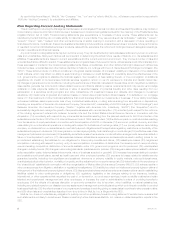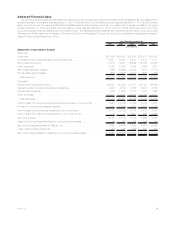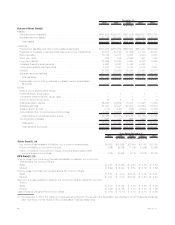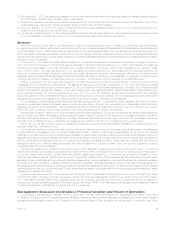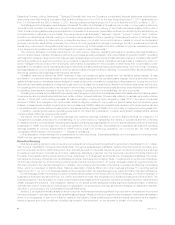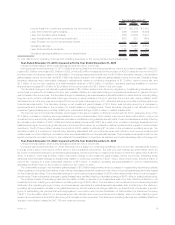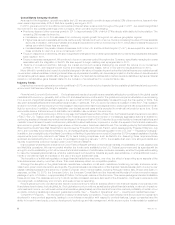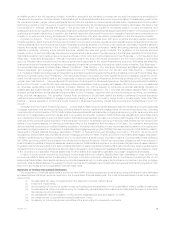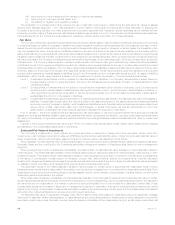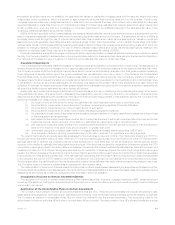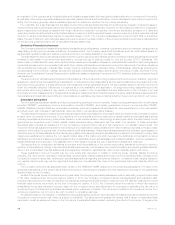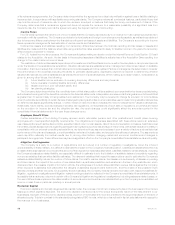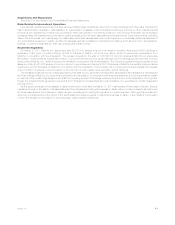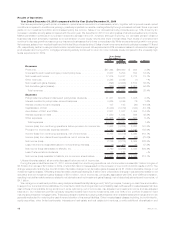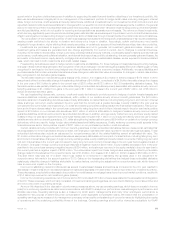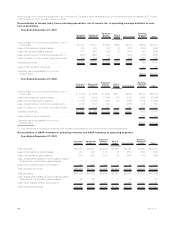MetLife 2010 Annual Report Download - page 15
Download and view the complete annual report
Please find page 15 of the 2010 MetLife annual report below. You can navigate through the pages in the report by either clicking on the pages listed below, or by using the keyword search tool below to find specific information within the annual report.an evaluation of the contractual and implied rights and obligations associated with each party’s relationship with or involvement in the entity,
an estimate of the entity’s expected losses and expected residual returns and the allocation of such estimates to each party involved in the
entity. The Company generally uses a qualitative approach to determine whether it is the primary beneficiary.
For most VIEs, the entity that has both the ability to direct the most significant activities of the VIE and the obligation to absorb losses or
receive benefits that could be significant to the VIE is considered the primary beneficiary. However, for VIEs that are investment companies or
apply measurement principles consistent with those utilized by investment companies, the primary beneficiary is based on a risks and
rewards model and is defined as the entity that will absorb a majority of a VIE’s expected losses, receive a majority of a VIE’s expected residual
returns if no single entity absorbs a majority of expected losses, or both. The Company reassesses its involvement with VIEs on a quarterly
basis. The use of different methodologies, assumptions and inputs in the determination of the primary beneficiary could have a material effect
on the amounts presented within the consolidated financial statements.
Derivative Financial Instruments
The Company enters into freestanding derivative transactions including swaps, forwards, futures and option contracts to manage various
risks relating to its ongoing business operations. To a lesser extent, the Company uses credit derivatives, such as credit default swaps, to
synthetically replicate investment risks and returns which are not readily available in the cash market.
The estimated fair value of derivatives is determined through the use of quoted market prices for exchange-traded derivatives and interest
forwards to sell certain to-be-announced securities or through the use of pricing models for over-the-counter (“OTC”) derivatives. The
determination of estimated fair value, when quoted market values are not available, is based on market standard valuation methodologies and
inputs that are assumed to be consistent with what other market participants would use when pricing the instruments. Derivative valuations
can be affected by changes in interest rates, foreign currency exchange rates, financial indices, credit spreads, default risk (including the
counterparties to the contract), volatility, liquidity and changes in estimates and assumptions used in the pricing models. See Note 5 of the
Notes to the Consolidated Financial Statements for additional details on significant inputs into the OTC derivative pricing models and credit
risk adjustment.
The accounting for derivatives is complex and interpretations of the primary accounting guidance continue to evolve in practice. Judgment
is applied in determining the availability and application of hedge accounting designations and the appropriate accounting treatment under
such accounting guidance. If it was determined that hedge accounting designations were not appropriately applied, reported net income
could be materially affected. Differences in judgment as to the availability and application of hedge accounting designations and the
appropriate accounting treatment may result in a differing impact on the consolidated financial statements of the Company from that
previously reported. Assessments of hedge effectiveness and measurements of ineffectiveness of hedging relationships are also subject to
interpretations and estimations and different interpretations or estimates may have a material effect on the amount reported in net income.
Embedded Derivatives
The Company issues certain variable annuity products with guaranteed minimum benefits. These include guaranteed minimum withdrawal
benefits (“GMWB”), guaranteed minimum accumulation benefits (“GMAB”), and certain guaranteed minimum income benefits (“GMIB”).
GMWB, GMAB and certain GMIB are embedded derivatives, which are measured at estimated fair value separately from the host variable
annuity product, with changes in estimated fair value reported in net derivative gains (losses).
The estimated fair values of these embedded derivatives are determined based on the present value of projected future benefits minus the
present value of projected future fees. The projections of future benefits and future fees require capital market and actuarial assumptions
including expectations concerning policyholder behavior. A risk neutral valuation methodology is used under which the cash flows from the
guarantees are projected under multiple capital market scenarios using observable risk free rates. The valuation of these embedded
derivatives also includes an adjustment for the Company’s nonperformance risk and risk margins for non-capital market inputs. The
nonperformance risk adjustment is determined by taking into consideration publicly available information relating to spreads in the secondary
market for the Holding Company’s debt, including related credit default swaps. These observable spreads are then adjusted, as necessary, to
reflect the priority of these liabilities and the claims paying ability of the issuing insurance subsidiaries compared to the Holding Company. Risk
margins are established to capture the non-capital market risks of the instrument which represent the additional compensation a market
participant would require to assume the risks related to the uncertainties of such actuarial assumptions as annuitization, premium persistency,
partial withdrawal and surrenders. The establishment of risk margins requires the use of significant management judgment.
The accounting for embedded derivatives is complex and interpretations of the primary accounting standards continue to evolve in
practice. If interpretations change, there is a risk that features previously not bifurcated may require bifurcation and reporting at estimated fair
value in the consolidated financial statements and respective changes in estimated fair value could materially affect net income.
These guaranteed minimum benefits may be more costly than expected in volatile or declining equity markets. Market conditions
including, but not limited to, changes in interest rates, equity indices, market volatility and foreign currency exchange rates, changes in the
Company’s nonperformance risk, variations in actuarial assumptions regarding policyholder behavior, mortality and risk margins related to
non-capital market inputs may result in significant fluctuations in the estimated fair value of the guarantees that could materially affect net
income.
The Company ceded the risk associated with certain of the GMIB and GMAB described in the preceding paragraphs. The value of the
embedded derivatives on the ceded risk is determined using a methodology consistent with that described previously for the guarantees
directly written by the Company.
As part of its regular review of critical accounting estimates, the Company periodically assesses inputs for estimating nonperformance risk
in fair value measurements. During the second quarter of 2010, the Company completed a study that aggregated and evaluated data,
including historical recovery rates of insurance companies as well as policyholder behavior observed over the past two years as the recent
financial crisis evolved. As a result, at the end of the second quarter of 2010, the Company refined the manner in which its insurance
subsidiaries incorporate expected recovery rates into the nonperformance risk adjustment for purposes of estimating the fair value of
investment-type contracts and embedded derivatives within insurance contracts. The refinement impacted the Company’s income from
continuing operations, net of income tax, with no effect on operating earnings.
As described above, the valuation of variable annuity guarantees accounted for as embedded derivatives includes an adjustment for the
Company’s nonperformance risk, which is subject to variability. The table below illustrates the impact that a range of reasonably likely
variances in credit spreads would have on the Company’s consolidated balance sheet, excluding the effect of income tax. Changes in the
12 MetLife, Inc.


